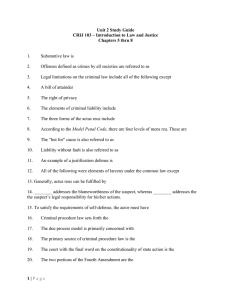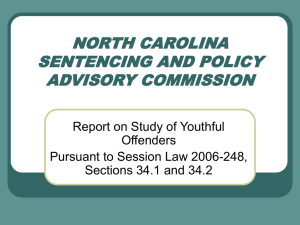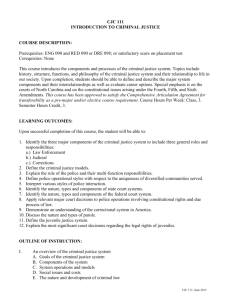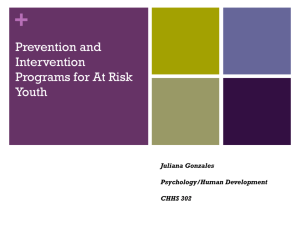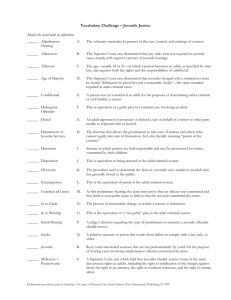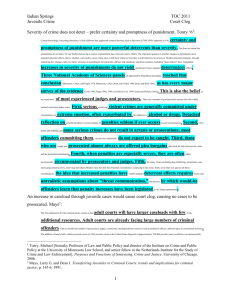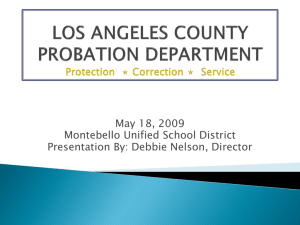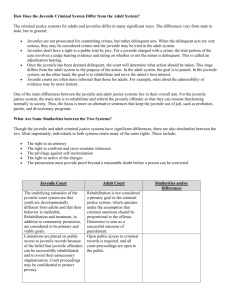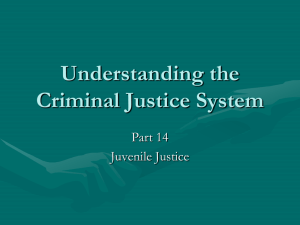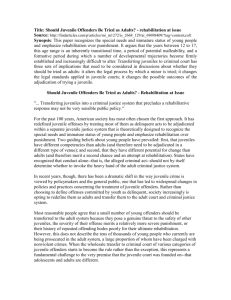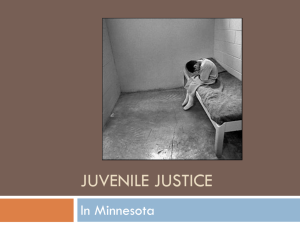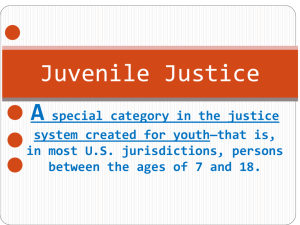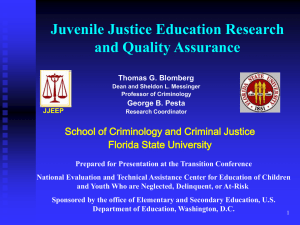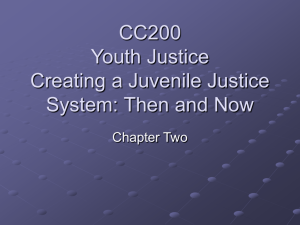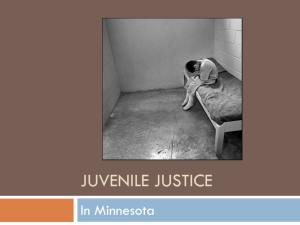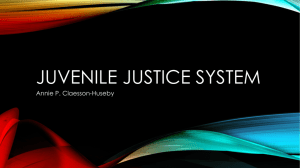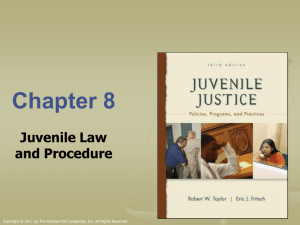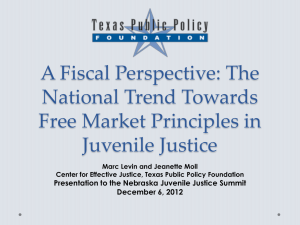Young Adults and the Justice System – Columbia 11.30
advertisement
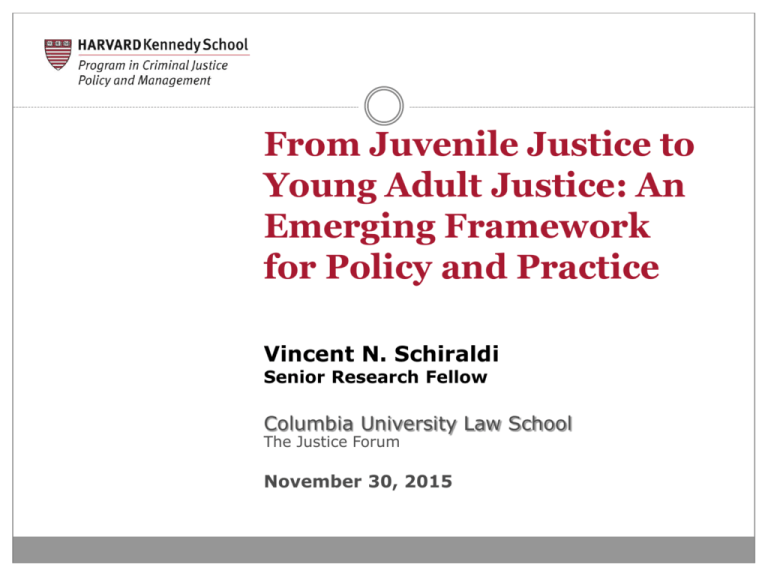
From Juvenile Justice to Young Adult Justice: An Emerging Framework for Policy and Practice Vincent N. Schiraldi Senior Research Fellow Columbia University Law School The Justice Forum November 30, 2015 Young Adult Justice 2 Historical Underpinnings Emerging Research Experiences in Other Jurisdictions Policy Recommendations November 30, 2015 Historical Underpinnings 3 In 1899 first juvenile court established, helps to legally define adolescence Relied on custom, culture or morality to determine age of criminal responsibility, ranging from 16-18 Late 20th Century 'get tough' movement questions very foundation of juvenile court Spawns research into whether young people really are different than adults - Justice Department and MacArthur Foundation November 30, 2015 Changing Life Course Markers Impact Resiliency 4 Today’s young adults enter into traditional, stabilizing adult roles at a later age 9% of 18-24’s were married in 2010, compared with 45% in 1960 Live separate from children and children’s mothers 27% of young African-American men between ages of 18-24 are disconnected from work and are out of school (20% in 1960) Non-college median earnings down from $40,000 (‘73) to $30,000 (‘07) for young whites; $34,000 to $25,000 for young African Americans This prolonged transition to adulthood taxes ability to forgo immediate gratification and prolongs reliance on peers vs. family November 30, 2015 Emerging Research in Neurobiology and Developmental Psychology 5 Part of the brain that modulates pleasure-seeking develops more quickly than the part supporting self-control, impulsivity has 'head start' over restraint Adolescents are: less able to regulate their own behavior in emotionally charged contexts more sensitive to external influences like peer pressure less able to make judgments impacting the future particularly true for youth who have suffered brain trauma Young adults resemble juveniles more than older adults November 30, 2015 Risk and Opportunity 6 Nationally, young Adults 13% of US population; 30% of arrests; 21% of prison admissions 78% rearrested within 3 years of release; highest of any age cohort In NYC, four in ten adult violent felony arrests involve young adults Once arrested, nearly 4 in 10 NYC young adults rearrested within a year - 3 times the rate of over 30’s Relatively few start their criminal careers after 25, most age out by 25 African American young adults 9-10 times more likely to be imprisoned that young whites November 30, 2015 States 7 Florida has had a youthful offender law since 1978 that allows the courts to use alternative processing for 18-21 year olds Michigan recently expanded the 'Holmes Youthful Trainee Act' to allow judges to sentence youth between the ages of 17-23 without having to incur a criminal conviction New York State’s Youthful Offender Law provides for certain confidentiality protections for those who are 16-18 Maine has a facility that includes young men aged 18-25 Connecticut Governor Dannell Malloy recently proposed to raise the age of family court through 20 and add confidentiality protections for those under 25 November 30, 2015 Cities and Counties 8 San Francisco established 'Transitional Age Youth San Francisco' (TAYSF), a collaborative network of city departments, providers, and young people to provide supportive services to help young adults succeed. SF opened a young adult court this summer and has had specialized probation caseloads since 2009 Multnomah County, Oregon has specialized parole caseloads with enhanced services for young adults New York City Department of Correction plans infacility programs and services, alternatives to incarceration, and reentry planning for 18-22 year olds Douglas County, Nebraska established a 'Young Adult Court,' a specialty court with judicial supervision for young adults up to age 25 who are charged with a felony November 30, 2015 Europe Generally has a Special Approach for Young Adults 9 57 49 21 Percent of 35 European countries surveyed had special rules in juvenile or general penal law Percent had penalty mitigation Percent had no special rules November 30, 2015 Countries 10 Germany: all 18-21 originate in the juvenile court; 2/3 stay there, mostly for more serious offenses whereas property and driving offenses go to adult court; separate facilities Sweden: Statutorily mitigated sentences and fines; “youth service” (community service/programming) available; more probation, less imprisonment Finland: No mandatories under age 21; enhanced good time for 18-21’s; fewer prison sentences and work/education oriented prisons The Netherlands raised the age of family court to 23 United Kingdom: Age as a mitigating factor; maturity assessments for 18-24 year olds; separate facilities controversial; Select Committee in House of Commons November 30, 2015 Policy Recommendations 11 Thoughts on what a more responsive system for Young Adults would look like November 30, 2015 How Can We Better Meet the Needs of this Population? 12 Raise the age of family court to somewhere between 21 and 25 Special package of programming and policies • SPECIALIZED DIVERSION • SPECIAL COURTS • CUSTOMIZED PROBATION Create a 3rd system for Young Adults CASELOADS • SEPARATE FACILITIES • CONFIDENTIALITY November 30, 2015 Further Reading 13 Community-Based Responses to Justice-Involved Young Adults Executive Session on Community Corrections http://www.hks.harvard.edu/programs/criminaljustice/research-publications/executivesessions/escommunitycorrections/publications/community-based-responses-to-justice-involvedyoung-adults The Case for a Young Adult Criminal Justice System Tracy Velázquez https://chronicleofsocialchange.org/policy-paper/the-case-for-a-young-adult-criminal-justice-systemby-tracy-velazquez/2683 From Juvenile Delinquency to Young Adult Offending OJP National Institute of Justice http://www.nij.gov/topics/crime/Pages/delinquency-to-adult-offending.aspx Various Publications Transition to Adulthood T2A http://www.t2a.org.uk/publications November 30, 2015 14 For more information www.hks.harvard.edu/criminaljustice Vincent_Schiraldi@hks.Harvard.edu November 30, 2015
